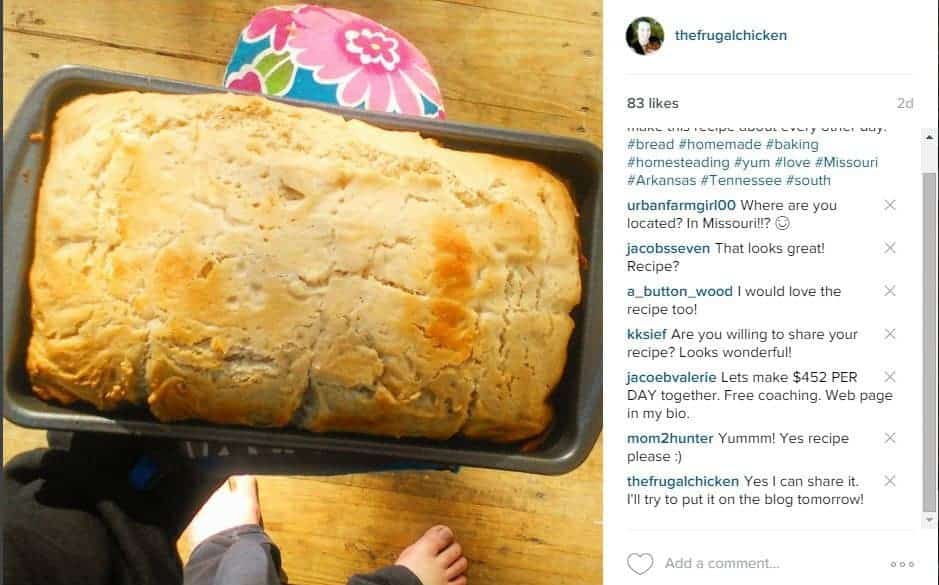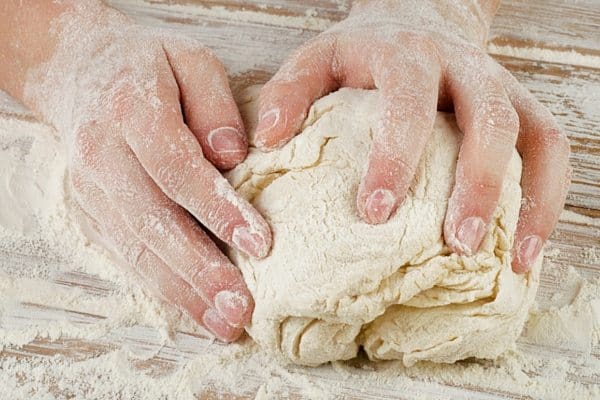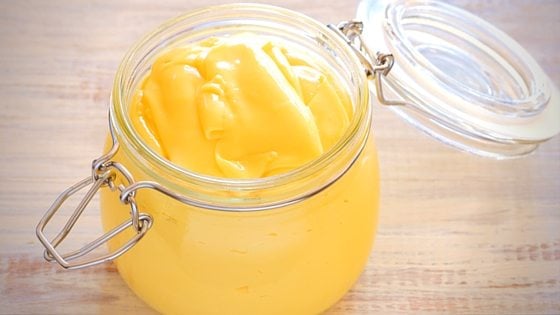Baking great bread isn’t a talent I was born with, but I’ve learned by trying easy recipe after recipe.
But, as I took homesteading more seriously, and because I wanted to avoid all the preservatives and “what the heck is that?!” ingredients in store bought bread, it was time to get off the pot, and learn a to make homemade bread.
So I started learning, but was intimidated by all those recipes that show a gorgeous loaf, perfectly prepared.
It’s insane! I never felt like I could be that good.
So, I started developing a recipe so I could make healthy bread, in my own kitchen, without having to worry about chemicals and the like.
It wasn’t that hard, really!
While my bread is still hardly Pinterest-worthy, it’s a good example of the kind of bread you can bake, easily, in your own home.
And the best part?
It doesn’t take much time or kitchen-savvy.
Just a half hour or so, and a desire to learn.
There’s some secrets I’ve learned to baking good bread consistently, which I’ll share with you in this easy bread recipe.
I developed this recipe for people like me in mind, who don’t have much time, but want to avoid buying bread at the store.
You can make my easy bread recipe for pennies on the dollar, and you’ll have a healthier, preservative-free product in the end.
I also want fast results, and a recipe I can turn to time and again.
This is that recipe.
My easy bread recipe yields one loaf of versatile bread that you can eat simply, with butter, or as part of a larger meal.
I like to eat it under homemade chili to make the meal heartier.
With my bread recipe, you’ll know your family is getting nourishing, healthy bread.
But first…
I’ll let you in on my bread secrets
So far, I only have a few bread secrets, but they’re big ones, and are important to this recipe.
For me, they’ve meant the difference between hard lumps of something that resembles bread, and a light loaf of crumb.
So, what are these secrets?
Secret 1: Always, always, always use bread flour
The all purpose stuff will work, but a good bread flour is essential.
You can find it in the same grocery store aisle.
Secret 2: Use warm water, 110 – 120 degrees to let your yeast activate. No warmer, no colder.
Warmer water might kill the yeast, and cooler water might prevent them from activating. Both mistakes can kill your bread making attempts.
The yeasts are freeze-dried, remember, but they’re living organisms, and they need to be activated to do their job in your bread recipe.
I’ve made the mistake of using 100 degree water, and the bread in this recipe came out very dense, and not at all light.
So, the temp does make a difference.
I do use a thermometer, which you can easily find at any store selling baking materials (suggestions at the end of this article).
You can either microwave the water for 1:30 minutes, making sure to test the temperature after to make sure it’s right for the recipe.
You can also heat water on the stove until it’s risen to the right temperature.
Give our yeasty friends a warm bath, and they’ll help you out in this bread recipe.
Secret 3: Let the yeast activate until you see a lot of foam.
Following secret 2 is this secret.
Yeast are living creatures, and their job is to produce a gas that will make your bread light and fluffy.
The longer they’re allowed to activate and do their thing (within reason), the better your bread will be, and it’s more likely you will have success with this recipe.
I let mine activate for 1/2 hour to 1 hour before dumping them into the other recipe ingredients.
Seriously, this step will change your bread making. But don’t skip the next step either….
Secret 4: Allow the dough to sit overnight before baking
Ok, I know this step kind of sucks because you need to wait.
But giving those yeast an extra few hours to do their thing yields incredible results.
If you want to bake right away, your bread will still be good.
But wait a few hours, putting your dough in a warm place…
Makes GREAT bread.
You’ll thank me.
Alright, now that we have that out of the way….
Ingredients
2 cups water (110 – 120 degrees)
1 cup white sugar
1 tbsp plus
1 tsp yeast
2 tsp salt
1/4 cup olive oil, plus more for brushing
6 cups bread flour
1 tbsp butter, for brushing
Directions
In a bowl, combine the flour, sugar, and salt.
In a separate bowl, combine the water and yeast, and stir to incorporate the yeast into the water.
Allow to sit for 30 – 60 minutes, or until you see a lot of foam.
This lets you know the yeast is doing its thing.
Right before adding the yeast, add the 1/4 cup of olive oil to the flour mixture.
Once the yeast is established, incorporate it with the flour mixture.
With your hands, start mixing the dough together, incorporating the yeast water and the oil to create the bread dough.
This only takes a few minutes, and you’ll know it’s done when the dough is fully incorporated and pulls away from the sides of the bowl.
To mix everything together, I like to mash the dough through my fingers, folding a couple times.
Once you’ve made your bread dough, brush some olive oil onto each side to prevent it from sticking.
This also gives it a nice flavor.
Cover the bread dough, and let it sit for 1 hour.
After 1 hour, return, and fold the dough in half once.
Allow to sit over night to let the yeast develop.
If you make your dough at night, you can allow it to sit until the following night, when you get home from work.
You can also simply pop it into the oven in the morning if you’ll be home all day.
Once the dough has risen, and it should have risen a lot, pour the dough into a non-stick loaf pan.
Make sure to smooth down the top of the dough so you don’t get any lumps in the crust.
Make one vertical slice lengthwise on the top of the dough, it does not have to be deep.
Then make two horizontal slices width wise.
These slices are to allow the dough to rise evenly in the oven without creating any weird lumps in the crust.
Cover the top of your dough with aluminum foil. This will allow the bread to bake consistently in the pan.
Preheat your oven 400 degrees, and wait for the correct temperature before putting the dough into the oven.
Bake for 30 minutes.
After 30 minutes, the dough should have risen and look like bread.
Now, remove the aluminum foil and brush the top of the bread dough with butter.
Place under the broiler, uncovered, for 10 minutes to darken the crust.
If it does not darken evenly, don’t worry – that’s part of the fun of making homemade bread in this recipe!
After the crust has darkened, remove the bread and allow it to cool for 30 minutes to an hour before cutting. This allows you to make even cuts without destroying the soft interior of the bread.
There’s a lot of steps, but after you make this recipe a few times, it will go like clockwork.
I’ve found this bread recipe to be pretty fool-proof, and if I can make it, so can you!
I’d like to hear from you!
What’s your favorite part of baking bread? Do you have a favorite recipe? Email me at editor@thefrugalchicken.com or comment below!
Maat van Uitert is a backyard chicken and sustainable living expert. She is also the author of Chickens: Naturally Raising A Sustainable Flock, which was a best seller in it’s Amazon category. Maat has been featured on NBC, CBS, AOL Finance, Community Chickens, the Huffington Post, Chickens magazine, Backyard Poultry, and Countryside Magazine. She lives on her farm in Southeast Missouri with her husband, two children, and about a million chickens and ducks. You can follow Maat on Facebook here and Instagram here.









My wife is huge into baking, and lately she’s been wanting to try and make her own bread. The problem though, is that she hasn’t been able to find a good recipe for her to use. That being the case, I really appreciate you giving me some insight about this and sharing this yummy sounding recipe with me. I definitely think that my wife is going to love this one! I’ll be sure to show this to her right away. Thanks for all your help.
Glad you like it. It’s a great recipe, I tried a different one last night, but this one is way better. It’s easy.
What size loaf pan does this recipe fit into?
I am trying to master the perfect bread. After multiple attempts, I am still working on it. I will try this method. Thank you!